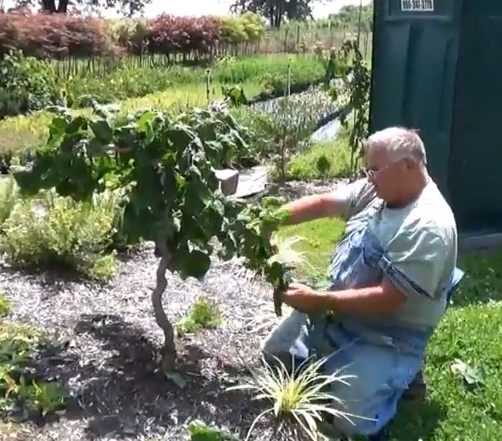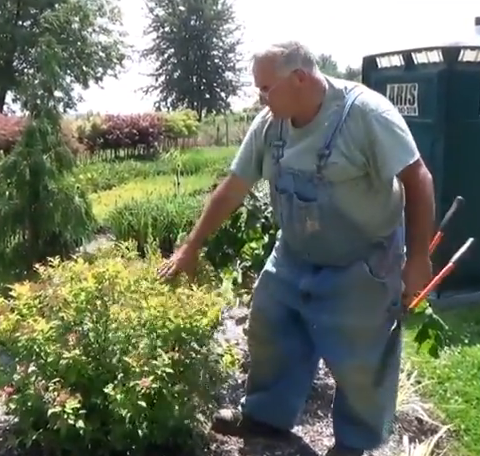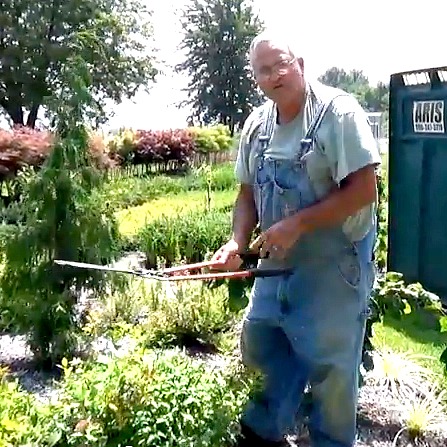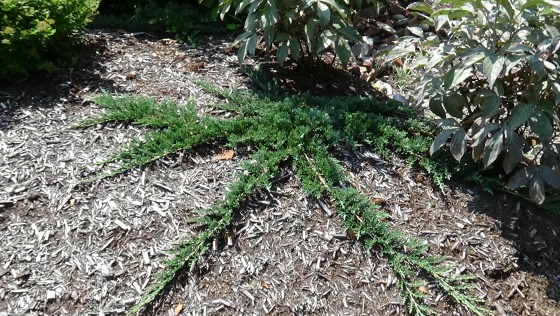When is the best time to prune shrubs in your landscape?
The answer is: When it needs it.
Some experts might tell you that you need to wait until winter or early spring to cut back your shrubs or trees. Here at Mike’s Plant Farm, we ignore the calendar and prune as needed.
We prune in early summer. The plants quickly flush out again with new growth. By late summer/early fall they are usually ready for another haircut.
Why do we prune?
We prune our landscape plants in the early summer to propagate the clipped pieces as softwood cuttings. This early summer trimming encourages a lot of new growth. In late August or September, we prune again to keep the size manageable, to encourage spring growth, and to help the plant fill out.
Clipping a twig back, flush against a main branch will discourage growth. General pruning, where the twigs are clipped mid branch will create more growth. It helps develop a fuller shrub with more compact branching.
How to prune a shrub.
Start at the top and work your way down. Try not to make your tops flat. Keep them slightly rounded.
Most (quality) hedge shears will have a slightly curved handle. Hold your shears so blades curve upward while cutting the top of your shrub. Flip it over so the blades curve downward while you cut the sides. This will help you to taper the sides into a rounded shape.
The most important thing to remember when pruning a shrub is not to cut the sides at an inward angle. This will cause the plant to shade itself and then it’s not going to grow properly or have nice coloration.
You’ll end up with small brown branches along the sides of your plant while the top grows quickly. Before long you’ll have an oddly shaped oval-ish shrub. Keep the sides rounded outward.
How much should I cut?
We take our shrubs back quite a bit. In the video below, you’ll see that Mike clips his spirea bushes to under 2 feet and they will grow back to 3 or 4 feet by next summer when its time to prune again. Remember, pruning promotes growth. Click here to see some of the crazy pruning jobs we get away with.

What about ornamental trees?
Go for it! Clip mid branch where you want to encourage fullness, and clip branches that you do not want back to the main branch or trunk. Cut any suckers back as far as you can. You want to get them back to the main root or as close as possible. Otherwise, they will just keep coming back in greater numbers.
Does ground cover ever need to be pruned?
Sometimes. Check out this blue rug juniper.
The arms on this blue rug juniper are stretched way out making it look like a starfish. It’s neat, but not the look we’re going for. We will trim up these runners to keep them from reaching too far beyond the body of the plant. We want to keep it confined to one specific area so that we have more of a blue rug and less of a blue tendril.
What shouldn’t I prune?
There is very little that we do not prune here at the nursery. We do not prune the tops of evergreens that grow on one leader branch, like an emerald green arborvitae or a Canadian hemlock.
Once you cut that leader branch, they stop growing upward and start growing outward…not a good look for pyramidal trees.
We hold off on pruning things like purple sandcherry or dappled willow because they propagate nicely as hardwood cuttings.
We want their branches to stay nice and long until its time to stick the cuttings in the winter after they have gone dormant. We’ll prune them in the winter and then they will begin filling out rapidly once again with new spring growth.
Check out this video on how to prune shrubs and other landscape plants!
Whether you are a grower who is looking to prune for propagation or a homeowner who is pruning for looks, I think you’ll find this video gives a helpful demonstration on how simple and easy pruning should be.




Hi Mike, can I prune my blueberries like bushes.
Mine are at least twenty years old . I’ve been pruning late winter early spring but this year they’re growing crazy. A lot of branches hanging down.
Thanks for all your teachings
Bill
Bill,
Yes you can!
Hi Mike, I appreciate very much your helpful info. I am assuming I missed something somewhere along the line, but could you please advise regarding when to prune for propagating fruiting plants like grapes, blueberries, etc. Thank you again. Jim Wendel in se az
Jim,
Grapes are easily done as hardwood cuttings in late winter. Same for blueberries, but they are tricky. They can also be done as softwood cuttings. http://mikesbackyardnursery.com/2015/01/easy-summertime-plant-propagation-techniques-can-home/
Hi Mike. What are the small green plants near tree you had pruned?
Belinda,
Not sure which you are referring to. Several spirea in that bed, as well as some Blue Star Juniper.
When looking at the above pic, there are three, chartreuse colored, spider-looking plants at the edge of your border before your ARIS container.
Belinda,
Either varigated Lirope or Blue Rug Juniper.
Much obliged.
I cut down an old mature caragana hedge, but have mounds of 6 inch high stumps. I want the caraganas to regrow in the same place. Will I get a decent looking growth leaving it that way or do I need to do something further with those stumps?
Eugene,
I can’t say for sure I think you will get what you want without more effort.
Mike, what is the best way to get rid of Kudzo
Bernadette,
Remove all of it and start working the soil. Keep working the soil, never letting new sprouts get more than 1/2″ tall. Eventually you win the battle.
My DAD (the “great Garderner”) always pruned between Nov. 15 and Feb. 15
in our area. This way growth would always come back in time for “pretty” seasons.
I’m still looking for Spirea in pictures.
I planted a Spirea and a Weigeia too close together. Now they have grown up-How can one be moved safely?
Rebecca,
Either can easily be moved when dormant.
I love your blog and always get very useful information to use in Washington state. I was wondering what you think of Quaking Aspens. I have thought of planting a few at our property line up above in our tiered backyard. What do you think?
I do as well!!!! Thank you so much Mike for all of your valuable information! It has helped me so much over the years! I have a question about pruning rose bushes. I have always waited to prune them back until Spring, but one of my friends swears that the best time is in the Fall before Winter comes. What is your opinion on this? Also, my holly bushes suffered severe “leaf scorch” from the extremely harsh winter conditions last year; between the cold winds and the cold temperatures, they sustained a good amount of damage. They are getting better, they are showing promise, lots of new green leaves coming, I have been cutting off the dead branches and leaves here and there. Is there anything else that I should be doing for them? Thank you so much for your help! 🙂
Marlene,
There are mixed views on this, some say spring pruning better protects the canes over the winter. Just keep doing as you are with the holly.
Hi Mike,
I want to transplant a couple of Japanese Maples. I planted them a couple of years ago and we will be moving in a couple of months and I would like to take them with me. I dug them up and put them in pots. My question is should I plant them yet this fall, or overwinter them and wait until spring? (We live in zone 4). What do you recommend?
Mary,
Plant them as soon as you can. Don’t put them in a wet area, do not plant them too deep.
My mums have gotten so tall due to my health and lack of pruning they have fallen over and laying on the ground. I live in mo. and it is Ist of nov. can i still prune and should i do something to help them stand up. please help me as of my deceased daughter planted them for me. i would love for them to thrive in her honor.
Thanks Mike, a long time fan.
Jean,
You can prune the mums all you want, you won’t harm them. Maybe get somebody to dig and divide them for you now or in early spring so they are more manageable.
I planted a 6-7′ Canadian Hemlock I bought at a nursery and discovered that the leader, i.e. the main stem of the trunk of the tree, had been cut. I wanted a tree to grow into a tree. I have since asked the nursery about selling me a tree that had no leader. My question is one of ethics/propriety. An employee at the nursery simply avoided my question, and told me that they just bend one of the nearby branches up and secure it to the leader stem and hope that it becomes the equivalent. Should a healthy tree have its main leader?
Philip,
I don’t think that having or not having a main leader is going to affect the overall health of a Hemlock. I understand your concern about the leader but I do agree that a new branch can be selected and trained as a leader. Some nurseryman are adamant about maintaining a single stem leader throughout the growing process of growing the tree. When the tree leaves their nursery the leader is intact. However, this seems to have more to do with old school values and many trees today such as Canadian Hemlock are grown without a single leader.
I hope this helps or at least makes sense.
I planted 2 firebush about 8ft apart 3 years ago. I never knew to cut them back & now I have 2, 6ft x 5ft around bushes, by trying to round them with hedge clippers. They are covering my 12ft living room window view, and I’m not sure how or if I can cut them back without killing them? Any help would greatly be appreciated
Jessica,
See this post. http://mikesbackyardnursery.com/2010/09/trim-your-burning-bush-way-back/
Hey Mike, I just happened on your site and really like it. Looking forward to setting up my own small propagation system for some emerald green arborvitae.
Anyway, I have a spiral juniper in front of my house in my landscaping beds that is leaning pretty bad. I suspect it gets the brunt of some wind. I put a metal stake in the ground today and used some zip ties to pull it back straight for now. What do you suggest I do to straighten this juniper up?
Brandon,
Getting this upright Juniper to stand straight is going to be a problem, I think you’ve done all you can do. Whether or not you can ever remove the stake is yet to be seen, but I’m thinking not.
Mike,
I really appreciate your great plant and horticulture advice!
We live in southern Saskatchewan (Canada) and are in plant zone #3a, really long cold winters). I have read through a lot of your postings. I have always been too cautious to give our yard’s bushes and shrubs a good pruning. I know I need to prune but I don’t want to somehow harm the plant or not allow it to grow on it’s own. You are convincing me that I need to be more aggressive with my pruning habits.
When is is too aggressive in pruning? Can you harm a plant by cutting it back too much or too often?
Plants species/varieties in our yard include:
– one purple leaf sand cherry bush – it could be fuller, lusher.
– two rose bushes – both are somewhat spindly and not as full as they could be.
– three globe caraganas – I’ve never pruned these, but I should have. They look OK..
– two dogwood species/varieties (red bark, green bark), red one is really nice, green one has struggled (It’s hanging in there, aphids problem).
– cottoneaster hedge – they look reasonably healthy, I’m trying to fill in a few gaps to make a complete hedge).
– one nanking cherry – really lanky and sparse.
– three junipers – one is large and could be nicer (a fair amount of dead foliage, winter kill?). Another is a dwarf variety that is doing OK, it could use some shaping (I water it a lot). A third one is not growing much and doesn’t have much new foliage, I wish it would start flourishing but it hasn’t.
Any special advice on pruning what we have in our yard?
Cory
Regina, Saskatchewan, Canada
Cory,
I’ve never met a plant that didn’t benefit from pruning. Heavy pruning should be done in the early winter, that would be ideal. Everything on your list can be pruned aggressively.
Thanks for the quick response Mike! So I should wait to prune until early winter? Even before our nasty Saskatchewan winters? What you may view as winter in Ohio is a different thing here in Saskatchewan.
Any advice on growing junipers? Our junipers are just not doing overly well.
Cory,
The past two winters in Ohio have been as low as 15 below, then last winter went down to 21 below. Our winters can be brutal. But we all get an early freeze then a few weeks of reasonable weather to work in. That’s the ideal time to prune. Junipers? Junipers are easy to grow once rooted. They don’t really need anything special at all. If yours are not doing well I’d consider replacing them, they might have spider mites.
So will you cut and stick all the branches and twigs you just cut off?
how do i prunne back azalia
look forward to seeing and reading Your site in Me email regularly. Thank You so very much, You have been a tremendous help to an Old-man and His small garden in His back-yard. Don’t live to far from Your place in Ohio. Signed Dick Irish-Erie Pennsylvania.
Do you prune lantana?
I have heard yes and no. Mine are getting Huge.
Thanks
Rebecca
Hi Mike,
I have recently starting watching your blog and enjoy it very much. My husband asked me recently if I know how to prune a lilac bush. I said no but I know who probably does. The lilac is currently about 10 ft tall and is starting to look pretty rough. Some dead branches and misshaped. Any recommendations would be appreciated. Thanks
Question-I have plants in the ground and want to have a fall sale, they are getting big. Good or bad idea? Live in a rural area so think digging as I sell them will be no problem, know that plants will start to go dormant and will lose their leaves as well.
Thanks for your expert advice Mike.
Love this post, great info and especially as I have been chopping at the bit to get pruning and haven’t been sure as to when or how.
I have some red twig dogwood (Cornus stolonifera) and varigated dogwood (cornus alba “elegantissima”). Prune now???
Prune when it needs pruning. Now, later, whenever it needs it.
They recommend that we prune out about a third of the canes each year in order to encourage new growth. Newer canes are typically a brighter red, while the older ones tend to get darker each year. Other than that, I have tried to prune back the top growth, and found that it resulted in more horizontal branching which looks ‘messy’ in the winter. I have the Ivory Halo variegated leaf variety, which frankly does not get as red as I had hoped for, so I grow it mainly for the foliage. I have four or five plants in a row, and since I do not want it to get too tall anyway, I end up cutting it to the ground about every five years.